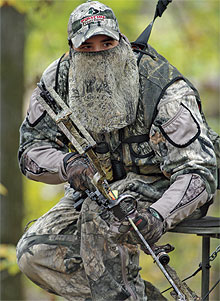October 28, 2010
By Randy Ulmer
By Randy Ulmer
 Deciding when to draw your bow is a huge factor in determining whether you'll put your tag on a bruiser buck this fall. |
One of the things I don't hear discussed much among bowhunters is exactly when to draw your bow when a buck is coming towards you. Drawing your bow requires quite a bit of motion, so it is the one action most likely to get you busted, especially if you do it at the wrong time or in the wrong manner.
There are basically two schools of thought on when to draw on a whitetail approaching your stand. I'll discuss the pros and cons of each and then tell you which method I prefer.
Advertisement
Wait Until The Time Is Right
The first method is to wait until the animal presents a good shot and then draw when he's looking away. If you use this approach, you'll never get stuck at full draw waiting for a shot that doesn't materialize. However, there is a risk in this approach. The animal is more likely to pick you out as you try to draw the bow if he is in range and in the open.
Also, he may not turn his head away and may move off before you have the opportunity to draw.
Advertisement
I know several bowhunters who use this approach. They wait until the animal is either in or nearly in their shooting lane to draw. I think television and videos perpetuate this approach, because they show hunters waiting to draw. The viewers fail to realize that the footage of the hunter drawing his bow is patched in later -- it is a cutaway. He may have actually drawn many seconds earlier than depicted on film. I see some real problems with the "wait until the time is right" approach.
Draw Early
The second technique is to draw your bow at the first good opportunity, once the animal is close to being in range. Common sense tells you that you'll never get a shot if you don't draw your bow first. So, getting the string back puts you in the right frame of mind and the right physical position to capitalize on any opportunity that presents itself.
The draw and wait approach means you'll have to hold the string back until the shot develops. As long as the animal is committed to coming your way and is moving at a moderate and consistent pace, you can draw while he is still out of range. The animal is less likely to see or hear you when you draw early, and you'll always be ready for the shot.
On the downside, the animal may slow down, change course or stop behind cover, forcing you to hold the bow back longer than you're able. Eventually, you'll have to let down, and this may spook the deer. Then, you'll have to draw again and shoot while you're fatigued. Another drawback is that this technique may force you to estimate the range without the aid of a rangefinder because the animal will be moving.
Which Approach Is Best?
The best method to use depends on a lot of variables, including how fast the buck is moving, how open the shooting lanes are and how spooky the deer is. In general, if the buck is spending more time moving than standing, I prefer to draw my bow at the first good opportunity as he approaches my kill zone. I don't want to be caught behind the action. Getting the draw out of the way is an important step toward getting myself in front of the action.
We've all heard that we should take the first good shot that comes along, because there may not be a second one. That is great advice, and if you are not at full draw, ready to aim and shoot, you may miss this opportunity and end up without a second chance.
From listening to stories in hunting camps, it is obvious many bowhunters wait too long to draw. The story is nearly always the same: The animal comes in but doesn't offer a good standing shot in the shooting lane, so they keep waiting before they draw. Or, the animal drifts off without affording the hunter a chance to draw and shoot.
During these encounters, the animal exposed its vitals a number of times for a few seconds. But it was fleeting and the hunter never caught up to the action because he wasn't at full draw and didn't have an aggressive mindset.
You don't always get the perfect shot. In fact, you rarely do. That doesn't mean you have to force a bad shot. I never advise taking a marginal shot. But if you are at full draw and ready for anything, you will be in position to make the most of every good (though brief) opportunity that comes your way. That is the art of converting encounters into freezer meat.
One last piece of advice: If you can't hold the string back for at least two minutes without shaking, you are shooting too much draw weight.
